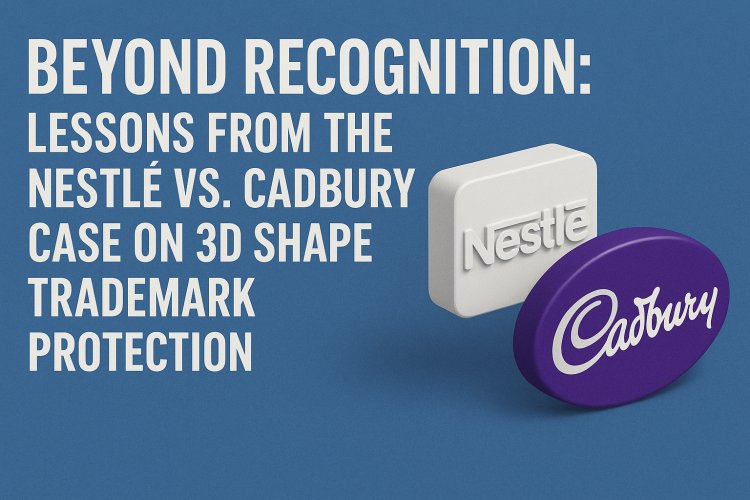Beyond Recognition: Lessons from the Nestlé vs. Cadbury Case on 3D Shape Trademark Protection
The landmark case of Nestlé v. Cadbury redefined the boundaries of trademark protection for 3D shapes, emphasizing that consumer recognition alone isn’t enough—perception of a product shape as a mark of origin is key. This analysis explores how the Court of Appeal’s ruling reshaped legal standards for acquired distinctiveness, the role of consumer perception in branding, and the implications for businesses seeking to protect product designs under trademark law.

Introduction:
In today's highly competitive business landscape, the importance of distinguishing one’s brand cannot be overstated, especially in industries flooded with similar products. One of the most crucial aspects of establishing brand uniqueness is securing trademark protection. The case of Société des Produits Nestlé SA v Cadbury UK Ltd exemplifies the challenges companies face when attempting to trademark not just logos or words but also the very shapes of their products. In this landmark ruling by the Court of Appeal, the intricate relationship between consumer perception, acquired distinctiveness, and trademark law comes to the forefront. Nestlé's submission to protect the distinctive four-finger design of its Kit Kat chocolate bar was met with Cadbury's staunch opposition, leading to a complex legal journey. This blog takes a deep dive into the case, elucidating the court's critical findings, the implications for businesses navigating trademark applications, and the broader lessons learned about brand identity and consumer behavior in the process. Join us as we unravel the significant legal precedents set forth in this landmark case and their real-world implications for branding strategies in competitive markets.
Understanding the Case: The Background:
The case revolves around Nestlé's attempts to trademark the 3D shape of its popular Kit Kat chocolate bar. In 2010, the company filed for registration, seeking to protect the distinct four-finger design that consumers immediately associate with Kit Kat. However, this legal journey was not straightforward. The product had been predominantly sold in opaque packaging, rendering the iconic shape invisible at the point of sale, and there was notable market presence from competing finger-bar products. Nestlé’s initial application met with immediate opposition from Cadbury, which questioned the inherent distinctiveness of the shape itself. Cadbury's challenge led to a prolonged evaluation process, during which the case was assessed at multiple judicial levels, ultimately reaching the Court of Appeal.
Nestlé’s Marks in Class 30 Are Below
|
|
Key Legal Issues:
Central to the case was the interpretation of Article 3(3) of Directive 2008/95/EC, which states conditions under which a non-distinctive mark may become registrable if it acquires distinctive character through use. The appeal brought forth pivotal questions, including whether the evidence presented by Nestlé demonstrated that consumers perceived the shape of the Kit Kat bar as an exclusive identifier of the brand, rather than just a functional or aesthetic design. Moreover, the issue of consumer reliance versus perception took center stage during deliberations. The Court had to determine whether consumers would associate the shape alone with the origin of the product without the presence of the well-known Kit Kat branding.
To know more about this you can follow the link below:
Court of Appeal’s Findings:
Upon examination, the Court of Appeal ultimately dismissed Nestlé's appeal, siding with the lower courts' findings. While the judges recognized that there was a strong association between the Kit Kat shape and Nestlé’s brand, this was insufficient for registration. The Court determined that recognition alone did not equate to perceiving the shape as a standalone identifier of the chocolate bar's origin. The judges relied heavily on the precedent set by the Court of Justice of the European Union (CJEU) in previous rulings, reaffirming the necessity for applicants to prove that consumers perceive the mark as denoting origin. The legal principle underscored that consumer behavior—reliance on the shape as a source identifier—is a viable consideration but is not, in itself, a requisite for establishing acquired distinctiveness.
Implications for Businesses:
The outcome of Société des Produits Nestlé SA v Cadbury UK Ltd serves as a critical reminder to businesses about the nuances of trademark law. Companies seeking to protect their product designs must be vigilant in ensuring that their brands are not only recognized but also perceived as unique identifiers of origin. For firms looking to register 3D shapes or similar non-traditional marks, this case emphasizes the need for substantial evidence demonstrating that consumers recognize and rely on the item as an indicator of quality and origin. Companies must invest in robust consumer surveys and marketing strategies that position their products as distinctive in the market. Additionally, the ruling highlights the importance of strategic branding that encompasses both aesthetic design and functional elements. The reliance on promotional materials and the visibility of trademarks at points of sale cannot be overlooked. Brands must consider how their products are presented to consumers and ensure that distinctive features are readily identifiable and associated with their business.
Lessons Learned:
1. Perception is Key: Recognizing a product shape is not sufficient in today’s competitive marketplace; businesses must ensure that consumers specifically associate that shape with their brand. This requires a multifaceted approach to marketing strategies that focus not just on brand promotion but on cultivating a robust brand identity. Companies should aim to create a lasting impression that enables consumers to identify their brand even when the product is presented without traditional branding elements. A well-defined identity can help maintain brand recognition and loyalty over time, even in the absence of visible logos or labels.
2. Consumer Surveys Matter: The process of gathering and presenting comprehensive consumer survey evidence is crucial in substantiating claims of acquired distinctiveness. Businesses should invest in understanding consumer associations and perceptions through empirical data collection methods, such as surveys, focus groups, and interviews. This thorough understanding can provide valuable insights into how consumers view the product shape in relation to the brand, thereby strengthening the case for trademark protection and establishing a strong connection between the shape and the brand in the minds of consumers.
3. Legal Precedents Shape Outcomes: Familiarity with leading legal cases pertaining to trademark law is essential for companies looking to navigate the complexities of trademark applications. Understanding how past cases have been adjudicated can offer valuable insights into how a present application might be assessed against existing legal frameworks. It is advisable for businesses to engage knowledgeable legal counsel who can provide guidance throughout the application process, ensuring that all aspects of trademark law are adequately addressed and increasing the likelihood of a successful outcome.
4. Navigate Market Competition: Maintaining awareness of competitors’ market presence is critical in the pursuit of successful trademarking. Firms need to conduct thorough research on how similar products operate within the marketplace, as this can significantly impact the feasibility of trademarking their own goods. Understanding the competitive landscape not only helps identify potential conflicts but also assists companies in differentiating their products effectively. By analyzing competitors’ strategies, businesses can develop their unique positioning that enhances their chances of obtaining trademark protection while also standing out in the marketplace.
Conclusion:
The case of Société des Produits Nestlé SA v Cadbury UK Ltd underscores the complexities inherent in trademark law, particularly surrounding the registration of 3D shapes. While recognition and association are crucial components of brand identity, they do not automatically confer the legal protection businesses seek. Ultimately, this decision serves as a pivotal learning opportunity for brands worldwide as they engage in the ongoing struggle to establish and maintain a distinctive identity within competitive marketplaces. Understanding these legal nuances is essential for navigating trademark registration and protecting intellectual property systematically and effectively.












